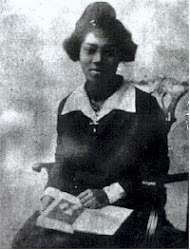Gladys Casely-Hayford
| Gladys Casely-Hayford | |
|---|---|
 | |
| Born |
May 11, 1904 Axim, Gold Coast |
| Died |
October 1950 (aged 46) Freetown, British Sierra Leone |
| Nationality |
British subject Sierra Leonean |
| Occupation |
|
| Spouse(s) | Arthur Hunter |
| Children | Kobina Hunter |
| Parent(s) |
Adelaide Casely-Hayford J. E. Casely Hayford |
Gladys May Casely-Hayford alias Aquah Laluah (11 May 1904 – October 1950) was a Gold Coast-born Sierra Leonean writer, daughter of Adelaide Casely-Hayford. She started the Krio language literature.[1]
She studied in Gold Coast (Ghana) and Wales, danced with a Berlin jazz band, and returning to Africa taught at her mother's Girls' Vocational School in Freetown. Her first poems were published in The Atlantic Monthly and The Philadelphia Tribune.[2] Her poetry has been widely anthologized.[3]
Early life and career
Gladys was born in Axim, Gold Coast on 11 May 1904. As a child, known then as Aquah LaLuah, she did not like textbooks or arithmetic but was a voracious reader, devouring Charles Kingsley's Heroes from cover to cover at the age of seven. She could sing, dance, and write poetry at an early age. Due to her upbringing she could speak fluent English, Creole, and Fante (the language of her father). She had her primary and secondary school education in Gold Coast and went to Penrhos College, Colwyn Bay, in Wales, after turning down two other competitive colleges that wanted her for her talented writing. Gladys stopped her education there and travelled with a Berlin jazz band as a dancer. She stayed with them for a long time, but started having breakdowns in 1932[4] and had to go home. Back home in Africa, she taught at her mother's Girls' Vocational School in Freetown, Sierra Leone.
Later life and work
Acquah Laluah then married Arthur Hunter.[4] At the school she taught African Folklore and Literature. She lectured extensively by dwelling on her pet messages that native Africans are not inferior to any race. She was bold in declaring this because she has been privileged to live among the Caucasians. Those messages of racial equality found their way into her poetry writings. She had very deep African roots in her poetry and anthologists of the Harlem renaissance loved her work. Hayford was very energetic and free in herself as well as in her writing. Gladys May used her energy and kindness to make better poetry. She used her self-expression to make a change in the world through her writing. Gladys May was not part of the talented tenth, but she did write about subjects that were more controversial at the time. Many of her poems emphasise women's freedom and pride and others reflected her life. She created many inspiring and great writings; Her first poems were published in The Atlantic Monthly and The Philadelphia Tribune. Her poems, such as "Nativity" (1927), "The Serving Girl" (1941) and "Creation" (1926), have been widely anthologized.
Death
Gladys May Casely-Hayford lived in Freetown, Sierra Leone, for much of her life. She moved to Accra, where her father's family lived, and where she died in 1950 of blackwater fever.[4] She had a son, Kobina Hunter (born 1940),[4] an engineer, and a stepson. Her grand niece, P. D. Casely Hayford is also a prolific writer.
Works
- Take'Um So, 1948 (poetry)
Notes
- ↑ Cary Nelson, "Gladys May Casely-Hayford (Aquah LaLuah) (1904–1950)", Modern American Poetry.
- ↑ Chipasula, Stella; Chipasula, Frank Mkalawile, eds. (1995). The Heinemann Book of African Women's Poetry. Heinemann. ISBN 978-0-435-90680-1. Retrieved 3 August 2012.
- ↑ See Countee Cullen, ed., Caroling Dusk: An Anthology of Verse by Negro Poets, 1927; Langston Hughes, ed., Poetry of the Negro World, 1949; African Treasury, 1960; Poems from Black Africa, 1963; Langston Hughes and Christiane Reynault, eds, Antologie Africaine et Malgache; Margaret Busby, ed., Daughters of Africa, 1992.
- 1 2 3 4 Crista Martin, "Casely-Hayford, Gladys (1904–1950)", "Women in World History: A Biographical Encyclopedia", Encyclopedia.com.